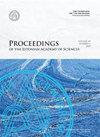Reasons for not participating in breast cancer screening, ways to obtain information and measures to improve participation in screening
IF 0.7
4区 综合性期刊
Q3 MULTIDISCIPLINARY SCIENCES
引用次数: 0
Abstract
. Breast cancer is the most commonly diagnosed tumor in women in the world. Early detection and treatment of breast cancer has an impact on life expectancy, reduced mortality and improved quality of life. The reduction in mortality depends largely on interventions. The objective of this study was to describe the reasons for not participating in breast cancer screening, ways to obtain information and measures to improve participation in screening. The survey was conducted among 1200 women aged 50–69 in Estonia. Statistical data analysis was performed with SPSS 26.0, using descriptive statistics. For comparison of the results with background data, the Mann–Whitney U test and the chi-square test were used. The main reason for not participating in breast cancer screening was the absence of symptoms. Information on breast cancer and breast cancer screening is mostly obtained from friends and acquaintances, and the least from the mobile application on breast cancer screening. The most desirable sources of information about breast cancer are information leaflets and the family doctor, and the internet is the least searched for information. Convenient access to a mammography examination and the family doctor’s initiative provide support, while the information in women’s magazines and social media has low importance for participation. The information channels used were related to age, native language and level of education. Place of residence did not affect access to information. The results show that women seek information primarily from friends and acquaintances, although they are also open to seek information from leaflets or the family doctor, indicating the need for more emphasis on those sources. Different sociodemographic variables should be considered in related communication.不参加乳腺癌筛查的原因、获取信息的途径和提高参与筛查的措施
. 乳腺癌是世界上最常见的女性肿瘤。乳腺癌的早期发现和治疗对预期寿命、降低死亡率和提高生活质量都有影响。降低死亡率在很大程度上取决于干预措施。本研究的目的是描述不参加乳腺癌筛查的原因,获取信息的途径和提高参与筛查的措施。这项调查是在爱沙尼亚1200名年龄在50-69岁之间的女性中进行的。统计资料采用SPSS 26.0进行统计分析,采用描述性统计方法。结果与背景资料的比较采用Mann-Whitney U检验和卡方检验。不参加乳腺癌筛查的主要原因是没有症状。关于乳腺癌和乳腺癌筛查的信息大多来自朋友和熟人,而来自乳腺癌筛查手机应用的信息最少。关于乳腺癌的最理想的信息来源是宣传单和家庭医生,而互联网是搜索信息最少的。便利的乳房x光检查和家庭医生的倡议提供了支持,而女性杂志和社交媒体上的信息对参与的重要性较低。使用的信息渠道与年龄、母语和受教育程度有关。居住地不影响获取信息。结果显示,女性主要从朋友和熟人那里寻求信息,尽管她们也会从传单或家庭医生那里寻求信息,这表明需要更加重视这些来源。在相关沟通中应考虑不同的社会人口变量。
本文章由计算机程序翻译,如有差异,请以英文原文为准。
求助全文
约1分钟内获得全文
求助全文
来源期刊

Proceedings of the Estonian Academy of Sciences
综合性期刊-综合性期刊
CiteScore
1.80
自引率
22.20%
发文量
24
审稿时长
>12 weeks
期刊介绍:
The Proceedings of the Estonian Academy of Sciences is an international scientific open access journal published by the Estonian Academy of Sciences in collaboration with the University of Tartu, Tallinn University of Technology, Tallinn University, and the Estonian University of Life Sciences.
The journal publishes primary research and review papers in the English language. All articles are provided with short Estonian summaries.
All papers to be published in the journal are peer reviewed internationally.
The journal is open to word-wide scientific community for publications in all fields of science represented at the Estonian Academy of Sciences and having certain connection with our part of the world, North Europe and the Baltic area in particular.
 求助内容:
求助内容: 应助结果提醒方式:
应助结果提醒方式:


